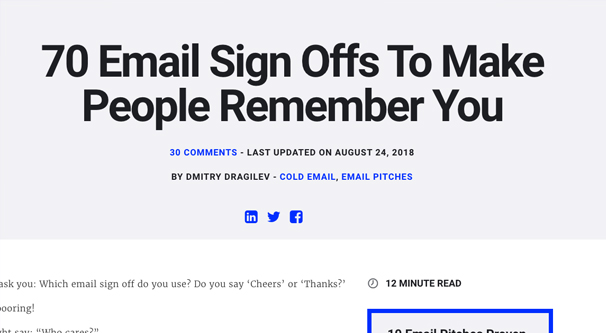12 Ways to Make Answering Emails a Little More Fun

Answering email can be a tedious and time-consuming task. The more you have to do, the longer it takes, and the less you want to do it. There are a million different email productivity tips and guides out there, and whether or not they work for you depends a lot on your personal inclinations and your situation.
One thing that typically works for almost everyone is just making email more fun. If you did a double-take at reading that, well, you’re not alone. Email? Fun? What nonsense is this? I can’t think of the last time I had fun reading and replying to emails.
Well, making email fun can be a good solution. Either you add some element of challenge to it to make it more interesting to compose replies, or you add something to make the entire experience more fun and interesting. The tips I’ve provided below will give you a bunch of different options. I recommend you pick one, maybe two of them at most; trying to layer all of them on top of each other will just make your inbox more of a circus than a business tool.
Before we begin, though, you should know a few things.
- Making your email fun is not always appropriate. There are definitely situations where informal email is unprofessional or un-called for. For example, you don’t want to receive a message from your lawyer with a random, “fun” anecdote in the middle of serious legal proceedings.
- You need to carefully consider the recipient when you decide if you’re going to do something fun. For example, you don’t want to include an in-joke with someone who won’t catch it, or include a meme when discussing something serious.
- You need to prioritize the actual purpose of your emails before you bother with the fun. If you’re responding to someone asking for support, for example, you don’t want to include an anecdote about support before you actually respond to the query.
- Remember that this method of adding fun to your email process won’t easily work if you’re also trying to streamline email with something like the three-sentence rule. If you’re trying to do something too contradictory, it won’t work out for anyone.
Now, with all of that said, let’s get on with the methods you can use to make email responses a little more fun, for you and for your recipient.
1. Include a Bit of Chat in Personal Emails
The first tip is one that can only really be used when you personally know the person you’re emailing. It’s useful for communications with coworkers, or with people you happen to know from other places who are emailing you for one reason or another. So what do you do? Just add a bit of small talk to your email.
I like to add it at the end, something like:
“Oh and hey, before I let you go, how’s your mom doing? I heard she was in the hospital, I hope she’s doing better now.”
A simple bit of small talk allows you to connect with the people you know on a slightly deeper level. Of course, some topics may not be appropriate. The above query after the health of a mother is fine if you suspect that they pulled through just fine, but if there’s a chance she didn’t make it, you’ve dredged up negative feelings in someone who is probably fighting pretty hard to keep them down. You can, instead, simply do more casual small talk. “Hey, did you watch the game last night? Wild stuff, huh?”
2. Add an In-Joke with Someone You Know
In-jokes are tricky business. If they’re light-hearted and you use them with people who are in on the joke, they can be a nice little way to exchange a greeting during the day. Think of it like a “secret handshake” through email. You and your friend reference something you both recognize, have a little smile about it, and move on with your day.
In-jokes can cause issues in some situations, though. If you use an in-joke with someone who doesn’t know a think about it, it looks like you’re just making a reference they don’t get, or worse, it could come across as some kind of semi-aggressive or mocking note. “Hey, check out this thing I know and you don’t” is needlessly antagonistic.
In some very rare circumstances, I have also seen in-jokes like this cause serious issues. In one case, the email was between a judge and a legal assistant, and the in-joke happened to be derogatory towards one of their coworkers. In this situation, due to other aggression, the emails were used as evidence and the judge was disbarred. Obviously, you don’t want to include anything that could ever be construed as any kind of harassment in your emails.
3. Include a Quotation You Love
A lot of people have a quotation as part of their email signature, but that doesn’t really add anything fun to your email experience. You have the fun of picking that one quotation and adding it to your signature, but that’s a one-time bit of fun and it doesn’t do much.
Instead, think about your favorite authors, your favorite speakers, your favorite actors, and other public figures, and think about quotes they may have said and the context of those quotes. I’m sure you can come up with something that fits the situation. Coming up with a quote that is somehow relevant to the situation can help give you some more meat for an email, especially if that email otherwise doesn’t have a lot to it.
Eventually, you can even build up a library of quotes you like to use for various situations, and keep that little reference handy for any time you want to send out an email. Including a fun, relevant quote – and making sure that quote doesn’t have historically negative context – can be a bit of fun for your email process.
4. Write an Anecdote
Anecdotes are like small talk on steroids. Telling a short story that has something to do with the situation at hand can be a good way to fill up some space on the page, give you something of a deeper connection to the person you’re writing to, and can make your emails feel more personal. Plus, if your boss walks by, you can be spending more time writing them so it makes you look more productive. This may or may not have an impact on your performance reviews, though, so be careful.
As with quotations and personal queries, anecdotes can be good but they can also backfire. If you tell a story that has some negative element to it, your choice of story may be considered inappropriate for work communications. It all depends on how much supervision you have and how strict the rules are for your email communication.
You also want to make sure that you’re not relaying a story that you shouldn’t be telling. A private happening outside of your work experience might not be an appropriate or worthwhile story to tell, and if people are expecting a professional message and get a personal story, it can be a negative experience for them.
5. Develop an Email Personality
More and more, businesses in general are finding that a casual, fun atmosphere and personality is important for reaching people and getting emails opened properly. One of my biggest examples is actually Discord, a Skype-like service aimed primarily at gamers. Discord’s entire personality, from their patch notes to their social media presence to their support emails, has some element of their personality come through.
For example, their regular email notifications have a “fun fact” typically related to video games at the bottom. Their main, official message takes center stage, but the fun fact is there in the main body, not in a signature.
Another example is when you try to make a regular payment for their service and the payment fails to go through. Their message includes the problem, a solution, and a bit of casual personality in the line:
“Otherwise, on <date>, we will shed regretful tears as we disassemble the Wumpus Wheel and cancel your subscription.”
Do note that some people don’t like this – just read the comments on that linked Twitter post – so make sure your brand can handle it if there’s backlash.
6. Gamify Your Email Responses
Years ago, there was an app called the Email Game, developed by the same people who made Boomerang. It was basically a timer that presented you with an email and asked you to decide what to do with it, and awarded you points based on the time left on the clock when you succeeded. Unfortunately, as of February of 2019, they have decided to retire the app.
Just because they didn’t find it profitable or sustainable to keep it running doesn’t mean you can’t do something similar, though. You can use timers and give yourself points based on your own rules, and even set up more advanced levels and challenges if you want to. You don’t need an app to handle it – even just a pen and some paper will do, if you establish your rules – but you can also consider coding up your own personal alternative.
7. Embed a Funny Social Media Post
Liven up the day for your email recipient with a funny, relevant, or charming social media post. You don’t necessarily have to embed, like, a Twitter post or something, of course. Even just saving and uploading a funny meme or image you like can be useful for giving a more fun, personal touch to your emails. Plus, you can inherently date yourself by sharing a meme that will age rapidly!
Alright, so this isn’t always an ideal option. I personally prefer to come up with something relevant and amusing in a way that depends more on the context of the email than it does on the greater world at large.
8. Give Yourself a Challenge
One thing you can do is try to give yourself some kind of challenge with your email composition. For example, maybe you could pick a common word and then try to make the first letter of each sentence spell out that word. It’s nothing harmful – so long as you don’t pick a word that could be considered offensive – and it’s not something most people will even notice.
For a more advanced version, you could even make a simple ARG out of it. Start writing encoded messages in your emails and have a prize waiting for the first person to point it out to you and solve the puzzle.
Of course, you shouldn’t do this if you’re creating a bunch of unnecessary work for yourself, or if you’re doing it in a situation that doesn’t call for it. No one is going to solve an ARG when all they want is support with login issues, for example.
9. Use a Word of the Day
Different dictionary services, like the Merriam-Webster dictionary or even just Dictionary.com, offer a word of the day service. Every day there will be a new word, and some of them will be very esoteric words. A fun challenge you can add to your email composition is figuring out an opportunity to use a word in a given day. I would say every email you write, except that won’t work when you’re using one of the more exotic words.
10. Customize Your Send-Off
How do you end your emails? Do you say “thanks for reading” or “sincerely” or do you just let your signature take care of it? You’re wasting a chance to add a little bit of fun to your email composition. Why not try out different send-offs?
This article has a list of 70 different options to use as inspiration. You can take them and run with them, use them when the situation is right, and make up your own to go along with it.
11. Use Humor to Apologize for Inconveniences
Adding some good humor to your emails can be beneficial when you want to diffuse a difficult situation. This one tends to work best when you’re writing emails that are responses to users who are having a hard time with something and are looking for support. Adding a bit of humor helps lighten the mood and diffuse the anger, but only if the rest of your email is a genuine solution. Remember, your fun elements of email have to be appropriate to the context of the email.
12. Write a Goofy Auto-Response
This is another option you can use in some circumstances. If you’re going on vacation and need to set up an out-of-office email response, or if you’re in a meeting and want to inform people of your potential delay, you can write a more interesting than factual auto-response. Here are some examples.
Have you found a way to spice up your email? I’d love to hear your ideas as well, just let me know in the comments.







